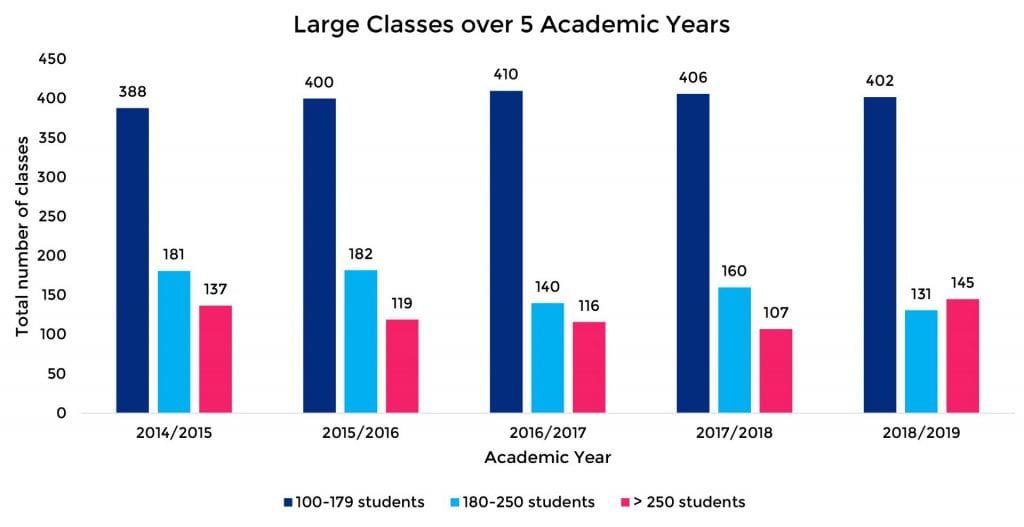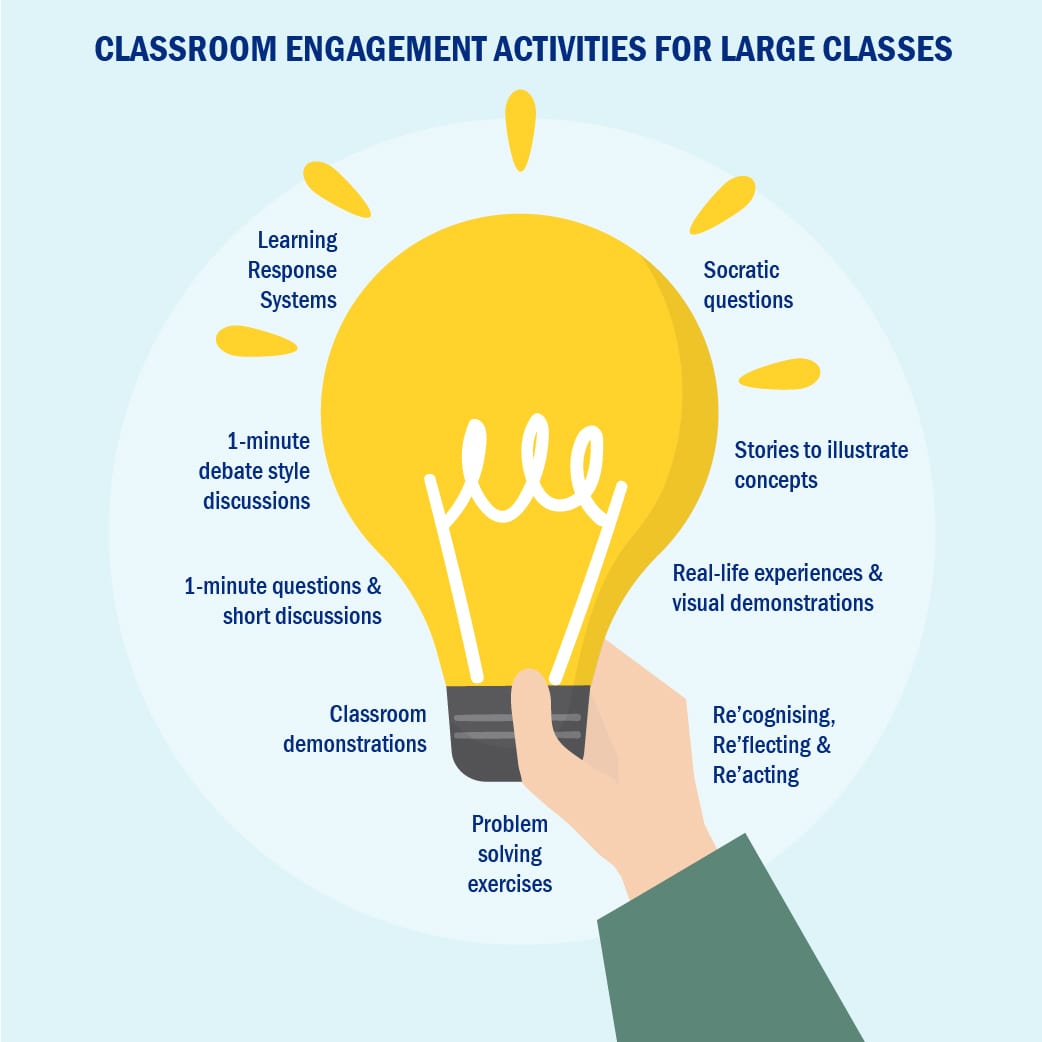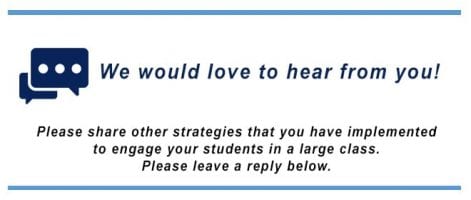
Introduction
In 2019, CDTLink embarks on a new series titled “Strategies for…”, where we revisit teaching and learning topics that continue to be an important part of our endeavour in engaging our students in learning. We invite faculty members to share a strategy on “Strategies for…” from their respective contexts.
We begin with the topic on “Engaging Students in Large Classes”. Many faculty members are involved in teaching large classes. In the context of NUS, we classify large classes into three categories – (a) lectures with an enrolment of above 250 students; (b) between 180 and 250 students; and (c) between 100 and 179 students.
Based on the classification and with the help of the Registrar’s Office, the number of large classes over the past five academic years, namely from AY2014/2015 to AY2018/2019, is as shown in Figure 1.
 Figure 1. Large classes at NUS over 5 academic years (Source: Registrar’s Office, NUS)
Figure 1. Large classes at NUS over 5 academic years (Source: Registrar’s Office, NUS)
The trend in the past 5 years shows that the number of large classes has either remained almost the same or increased, in particular for classes with student numbers of between 100 and 179. These large classes comprise all module levels, from Year 1 to Year 5. Interestingly, while there seems to be a decrease of classes in the range between 180 and 250 students, there has been an increase for classes with students above 250. For these two latter categories, most of the module levels are at Years 1 to 3. In short, what the data from the five academic years show is that teaching of large classes is still a key teaching activity for many of our faculty members.
The introduction of webcast and video-recorded lectures in the flipped approach has added a new dimension to engaging students in large classes. Nonetheless, as noted by Exeter et al. (2010) who investigated teaching practices of teachers who taught very large classes (e.g., 1000 students), there are three key principles used by effective teachers in engaging students. These are (a) course management, such as having different teachers who are the experts in certain areas to teach respective topics, (b) the use of different in-class strategies, and (c) continuing to engage students outside of class.
Chi (2009) Interactive-Constructive-Active-Passive (ICAP) framework is one guide teachers could refer to in ascertaining the level of student engagement of the strategies they use in lectures, as illustrated in Figure 2 below:

Figure 2. ICAP framework (Source: Chi, 2009)
Table 1
ICAP framework: Descriptions of the learning process and examples (Chi & Wylie, 2014)
Learning Process Description Example
Passive Receiving instruction without overtly doing anything else Listening to a lecture
Active Selecting or manipulating parts of the learning materials that cause focused attention but lack awareness of generating ideas beyond what is provided Taking verbatim notes during a lecture
Constructive Producing output that contain ideas that go beyond the information presented Drawing a concept map or a diagram
Interactive Dialoguing substantively on the same topic, and not ignoring a partner’s contributions Reciprocally teaching to other's questions
In our local NUS context, what are strategies that have worked for large classes/lectures? In the following infographic, faculty colleagues share concrete examples, strategies, or techniques that have worked for them.

Faculty Sharing
Stories to illustrate concepts

![]()
Strategy:
“Stories capture our attention in a way that little else does. And they persist in our memory; they are ‘psychologically privileged’. If I can find a story that illustrates an economic concept, I have hit a home run.”
Name: ONG Ee Cheng | Economics, FASS
Featured Module: EC1101E Introduction to Economic Analysis
Class Size: 400-600
Duration: 1 hr 35mins/lecture session
Real-life experiences & visual demonstrations

![]()
Strategy:
“The study of Engineering Principles is always perceived as a difficult subject. I infuse real-life experiences into my lectures to make the material easier to understand and easier to learn. I also use visuals such as videos, animations, and images as they excite young minds, capture their interest, and enrich classroom learning.”
Name: QIU Anqi | Biomedical Engineering, FoE
Featured Module: BN1102 Engineering Principles & Practice
Class Size: 150
Duration: 1 hr 35mins/lecture session
Socratic questions

![]()
Strategy:
“To engage students in the Biodiversity module, I try to ‘Entertain, Excite, and Expose’.
In this fundamental but data-intensive module of unfamiliar content, I ‘entertain’ by infusing elements of fun through small groups, board games, social interaction but also by lecturing in digestible components to scaffold learning. To ‘excite’ involves Socratic questioning as I move about in a large class to seek out student response and dialogue. Local and global efforts in investigation and discovery are important and are coupled with accessible quizzes to prepare or re-engage them with particular topics. Ultimately to ‘expose’ is the critical element – students participate in field trips and other out–of-classroom activities in the natural environment to provide an authentic experience unavailable in the most inspiring lecture. Coupled with detailed and clear module guidelines, this integrated supports a deeper understanding of the topic.”
Name: N. Sivasothi | Biological Sciences, FoS
Featured Module: LSM2252 Biodiversity
Class Size: 150
Duration: 1hr 35 mins/lecture session
1-minute-questions & short discussions

![]()
Strategy:
“I found the “One-Minute-Question” cum short discussion to be most effective in engaging students in my lectures. Typically, I would deliberately weave in one question after every 15 to 20 minutes of concept presentation. Students are given the option during the lecture to pair up with their neighbour to discuss and share the solution when called upon. This activity breaks down the monotony within the lecture, maintains their attention and encourages them to think critically and integrate the ideas presented."
Name: ONG Pei Shi | Pharmacy, FoS
Featured Module: PR1140 Pharmacy Professional Skills Development I
Class Size: 160-180 students
Duration: 1 hr 35mins/lecture session
Classroom demonstrations

![]()
Strategy:
“At the previous student feedback exercise, bridging students opined that they found physics to be ‘an alien subject’ which was challenging to learn.
To dispel this perception and raise their interest in the subject, it was essential to inject fun into the lectures and tutorials. During PC1221 lectures, I use teaching aids such as props, laboratory apparatus, videos (purchased and self-made), and showmanship to engage my students, and hopefully show them that physics is not such an alien subject after all.”
Name: TAY Seng Chuan | Physics, FoS
Featured Module: PC1221 Fundamentals of Physics I
Class Size: 170
Duration: 1hr 35 mins/lecture session
Problem-solving exercises

![]()
Strategy:
“At the beginning of each lecture, I pose a short problem for students to solve on the spot, individually or in small groups. Then, I solve the problem and highlight previously taught ideas and concepts that inform the solution. After class, these exercises will be appended to a document shared on the IVLE. I believe they help students warm up, both mentally and physically, to learn new material in the lecture. The document is also valuable as a reference, both during lecture and the tutorial. To students, the activity also serves as good practice for the examinations."
Name: YAP Von Bing | Statistics & Applied Probability, FoS
Featured Module: ST2132 Mathematical Statistics
Class Size: 200
Duration: 1 hr 35mins/lecture session
1-minute debate-style discussions

![]()
Strategy:
“At intervals in my lectures, I use competitive debate-style discussions to engage students. I will feature a particular concept/policy on the slide, and then divide the lecture hall into two halves. All students in each half have to argue one of two opposing perspectives of the issue. For example, while debating a land use concept/policy students in one half will argue for the policy while the other half argues against it, each half competing to suggest as many arguments as possible within the one minute allocated to this activity. The lecture is designed such that the pertinent arguments highlighted would be addressed as the lecture progresses. This is a quick way to encourage students to think fast, both creatively and critically."
Name: Grace WONG | Real Estate, SDE
Featured Module: RE1701 Urban Land Use & Development
Class Size: 180
Duration: 1 hr 35mins/lecture session
Learning Response Systems (Archipelago)

![]()
Strategy:
“To retain students’ attention during lectures, we developed Archipelago, an online real-time classroom response system. I use Archipelago to post questions at the start of the lecture to ascertain students’ initial understanding of the topic. I weave their responses into the rest of the lecture, building on incomplete thoughts and clarifying misconceptions. To break the monotony, I introduce short quizzes (e.g. MCQs, short-answer questions, point-and-click picture-based questions) about four times throughout the lecture. I do this to gauge students’ level of understanding and more importantly, get them to think more deeply about the topic."
Name: SOO Yuen Jien | Computer Science, SoC
Featured Module: TIC10021 Introduction to Computing And Programming I; TIC1002 Introduction to Computing And Programming II
Class Size: 100-250
Duration: 1hr 35 mins/lecture session
‘Re'cognising, ‘Re'flecting and ‘Re’acting’

![]()
Strategy:
"I use a multimodal approach to teach large classes with diverse learners, a ‘Re'iterative 3-step cycle of ‘Re'cognising, ‘Re'flecting and ‘Re’acting.’
Name: CHEN Zhi Xiong | Physiology, YLLSoM
Featured Module: MD1140 Normal Structure & Function; LSM3212 Human Physiology: Cardiopulmonary System
Class Size: 150-300
Duration: 1 hr 35mins/lecture session
Acknowledgements
CDTLink would like to thank the Registrar’s Office for providing information on modules with large numbers, and colleagues who have so generously shared their experiences with us on how they engage their students in large classes.
References
Chi, M. T. H. (2009). Active-constructive-interactive: A conceptual framework for differentiating learning activities. Topics in Cognitive Science, 1(1), 73-105. https://doi.org/10.1111/j.1756-8765.2008.01005.x
Chi, M. T. H., & Wylie, R. (2014). The ICAP framework: Linking cognitive engagement to active learning outcomes. Educational Psychologist, 49(4), 219-243. http://dx.doi.org/10.1080/00461520.2014.965823
Exeter, D. J., Ameratunga, S., Ratima, M., Morton, S., Dickson, M., Hsu, D., & Jackson, R. (2010). Student engagement in very large classes: The teachers’ perspective. Studies in Higher Education, 35(7), 761-775. http://dx.doi.org/10.1080/03075070903545058.



I find large classes nearly impossible to teach, especially as the lectures are webcast which essentially means that the students come to class primarily to socialise with their friends.
In most large classes in the school of medicine that I have sat in (for peer review or other reasons) or taught, there is a constant buzz of chatter from students who have torn themselves away from their facebook pages or instagram accounts.
My approach is not a good one but I tend to find the most inconsiderate student, call him up (*yes, it is sadly most often a male student) and ask him a difficult question in public. That tends to silence those around him for a little while until they feel the need to go back to taking advantage of the opportunity for social banter and catching up that the comfortable lecture hall provides.
Some of the ideas here on this page about using quizzes etc are very good but I think I am a bit too technologically challenged to do most of them.
Students often ask my why we are the only medical school in town (i.e. not LKCSOM or Duke-NUS) which still does large lectures and I have to admit that I am not sure about the answer to that question. Maybe we do want them to socialise and meet up to build up camaraderie?? It is a pity that the poor lecturers have to be the backdrop to that!
Hi Prof. Tambyah,
I learned that rapport with students help a lot. However, the constraints are 1) time and 2) breaking into student-student rapport.
1) University lecturers rarely get the luxury of time for the amount of interaction required to build teacher-student rapport for effective learning.
2) The unique social structure of SOM students in the form of CGs and Houses mean that their social connectedness with one another is probably stronger than most schools/faculties. This is not a bad thing and we probably do not want to reduce or break it up. However, it would be challenging for teachers to break into this ‘circle of trust’ to build rapport for more effective classroom management.
I have attached some links on this topic for your reading interest.
https://www.psychologicalscience.org/teaching/tips/tips_0301.html
https://nca.tandfonline.com/doi/abs/10.1080/03634520903564362#.XLAlbS-p3-Y
https://journals.sagepub.com/doi/abs/10.1177/0098628312475033
If possible, I would love to chat more with you or anyone else to exchange views on this topic as well as learn from one another on other instruments/strategies of classroom engagement.
Please feel free to contact me at zhixiong_chen@nus.edu.sg
Warmest wishes,
zx
Establishing the culture of random calling on students (as you proposed) can be a useful strategy for broadening student engagement and participation if used thoughtfully. If it seen as a penalty, then it is likely to more harm than good (Tanner, 2013). It could also be helpful if you can establish classroom community norms at the beginning of the semester, in which you discuss your expectations, policies on classroom disruptions. Alternatively, you can spend the first class getting students to collaboratively develop these ground rules.
You rightly pointed out that lectures are social events, but that social buzz can be channeled to build a shared communal understanding (French and Kennedy, 2016). They also go on to emphasise that there is a place and value for large lecture classes. We can use it to (1) provide context and structure for a subject, (2) offer a sustained argument and narrative, (3) enthuse and inspire students through our liveness and presence, (4) develop students’ note-taking and listening skills through intentionally planned activities, (5) present up-to-date research and model behaviour.
I have listed two great articles that may be of interest:
Tanner, K. D. (2013). Structure matters: twenty-one strategies to promote student engagement and cultivate classroom equity. CBE – Life Sciences Education, 12(3), 322-331. https://www.ncbi.nlm.nih.gov/pmc/articles/PMC3762997/
French, S. & Kennedy, G. (2016). Reassessing the value of university lectures, Teaching in Higher Education. DOI: 10.1080/13562517.2016.1273213
I totally agree with you that students chatting in a classroom (any classroom, really) can be a challenge. Here are a few ideas:
1. As long as students are chatting, I don’t speak. Sooner or later, students will catch on to the fact that they’ll have to keep quiet if they want class to continue (and if they want to get out of class on time). Some of my colleagues do this as well, and it’s pretty effective.
2. Provide time and space for students to talk. Every 15-20 minutes or so, students will work on a reflection/discussion question or a mathematical/graphical problem. There’s some quiet time for them to work on the problem or jot down their thoughts, but they also have a couple of minutes towards the end to discuss their answers with their friends.
3. The lecture slides that I provide to students are not “complete.” I leave some key words/phrases as blanks, and students have to fill in these blanks as the lecture progresses. This way, students have to pay attention, and are therefore less likely to be chatting with each other.
4. Sometimes students are chatting and not paying attention because they think they can learn the material on their own. In this case, maybe the class could be reorganized or flipped. This is a more drastic and costly change, but it can be worthwhile in the long run. The idea is to extract as much value as possible from the time spent in lecture.
Here’s the idea: Students do the readings before class. They take a quiz, so they can see what they’re getting wrong. In class, the professor explains the concepts that students are not getting, then students work on more problems.
I’m sure CIT can provide help if you want to implement to implement quizzes and have students submit their answers. Sometimes I use Poll Everywhere, but usually I just do the old-fashioned “raise your hands if you think the answer is A.”
Here’s a video showing what Eric Mazur does in a Physics lecture.
https://www.youtube.com/watch?v=wont2v_LZ1E